Am I living in the 21st Century? Perambulating the art world, there are times when my senses tell me I am, but my overall experience feels stuck in the conceptual mire of minimalism, emptied of the latter’s social gravitas, while at the same time standing in the wake of relational dystopia. All this, even before I consider those in this world who have the power to shape my experience of art. If there is one artist who has the ability to shake me out of this Gen X-Y, zombie trance of ironic equanimity and break this century open, it is Clifford Owens.

Clifford Owens. Anthology (Jennie C. Jones). C-print. 30x40 inches. Image courtesy On Stellar Rays.
“Breaking open” is the operative phrase in describing Owen’s solo exhibition Anthology at MoMA PS1.* The phrase functions on the level of history and on our present experience of race, class and gender, both in the art world and beyond it. The exhibition is comprised of “performance scores” given to Owens by over twenty inter-generational Black artists, all of which he performed and documented during his five month residency at PS1.
By acting as the vessel through which Black art is anthologized, Owens puts himself in a space that is fraught with struggle and contradiction. He sustains his own image as a Black artist by obliterating the notion that there is a unified definition of Black art, and as such, he also problematizes the way an anthology is supposed to function. Different scores seem to scrape against each other, creating a conceptual friction between identity and its meaning. Through his labor, Owens reveals a broken narrative of Black history, and Black art history, with himself at the vortex, channeling the ideas of his fellow artists while serving as the site and subject of his audience’s projections.
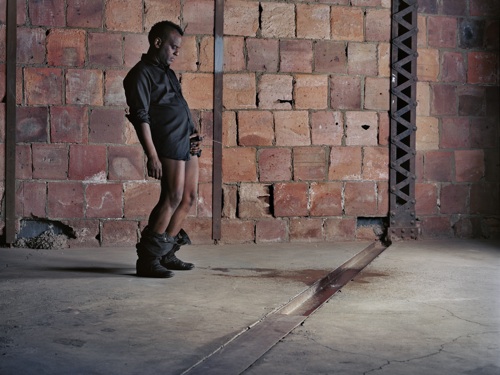
Clifford Owens. Anthology (Glenn Ligon), detail. 3 c-prints. 20x24 inches. Courtesy On Stellar Rays.
This is a hard place to be. Where, exactly? In Clifford Owens’s body, within the institutional structure of PS1, in the 21st century–where post-race discourse has subsumed post-colonial discourse–and even in my small, white woman’s body. For me, walking through Anthology feels like walking among the shards of a cultural suicide bomb. The texts, photos and video works appear to fit together to form a smart, visually stunning installation in which the combined works reflect multiple histories, from Fluxus to Minimalism to Body Art. Owens’s own project–to reflect a heretofore invisible history of Performance Art by Black artists–is embodied by his interpretation of the scores. On close inspection, the scores’ contents are rife with conflicts about what it means to be Black, to be a man, to be inventing a history, to be re-staging a history, and ultimately, to be staging oneself.
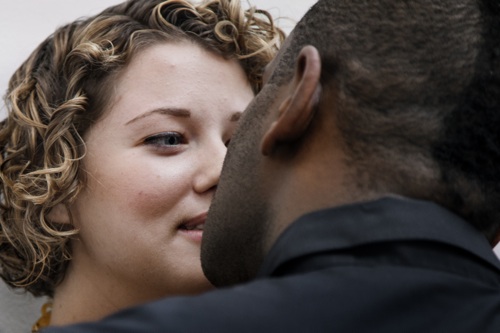
Clifford Owens. Anthology (Kara Walker), detail. C-print. 16x24 inches. Image courtesy On Stellar Rays.
As part of the exhibition, Owens is performing various scores on a monthly basis, through March 2012. I had the opportunity to participate in his performance of Kara Walker’s score during the exhibition’s opening. The following is my account of the experience.
We are all lining the hallway of the 3rd floor in front of the Anthology exhibition at PS1. Owens hands Walker’s score to curator Christopher Lew, and asks him to read it aloud. “Score: French kiss an audience member. Force them against a wall and demand Sex. The audience/viewer should be an adult. If they are willing to participate in the forced sex act abruptly turn the tables and you assume the role of victim. Accuse your attacker. Seek help from others, describe your ordeal. Repeat.”
Owens then saunters up and down the hall, eyeing people, pausing, considering the bodies of different audience members. From my vantage point, I am only able to see one side of the performance. Owens seems to prefer approaching white women. He goes up to one woman repeatedly and lightly touches her hip, the outline of her ass. She holds her body tenuously, allowing the touch but turning her head away from his gaze. He backs away. He turns toward another woman standing against the opposite wall. They kiss and he begins to feel up her shirt. I don’t know what initiates the breaking apart, whether she says no, turns her head, or he senses that she can go no further.
Owens advances toward another woman who is not white. She crosses her arms and keeps them crossed. He plays with her scarf, she stands still with a steely look in her eyes. He continues on to a woman who appears to be in her 50’s, distinctly older in age than the majority of his choices thus far. This gets steamy. They make out for a while and she, unlike the other women, wraps her arms around him and brings his body close. He touches the lining of her pant-zipper and she appears to be deciding whether or not to permit more. She says “no,” and they hold each other’s gaze for an instant before he stops. In between each new advance on different audience members, Owens asks Lew to re-read the score aloud, which serves to build suspense among the audience via the persistent language of coercion. Owens wears an affect of confidence as he takes time to gaze at everyone; there is a sense of power in his gait, and a force driving his experiment that fills the space with a subtle sense of terror.
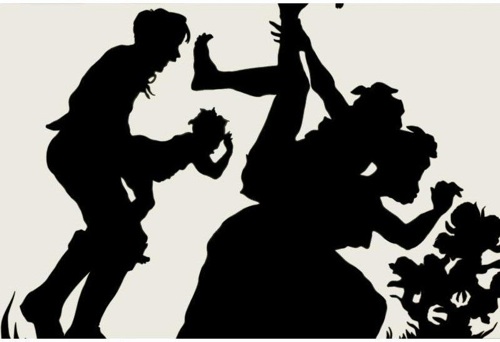
Kara Walker. Untitled, 1996. Image via https://www.mutualart.com/.
On a theoretical level, part of me expected to feel both turned on and at least mildly terrified. The score seemed to bear directly on Walker’s own work, where silhouettes of compromising master-slave relationships illustrate the underbelly of power dynamics within imagined sexual tableaux. A video and photographs of Owens’s previous performances of Walker’s score line one wall of the PS1 exhibition. Before participating in the performance, we as audience members had the chance to see how others had reacted and “performed”during the score’s previous iterations. So by staying, by agreeing to participate in a scenario that we’d already been given glimpses of, we as audience members were also complicit in the performance’s unfolding.
Yet on a personal level, for me Owens’s actions spoke to more than merely a demonstration of a concept. As he perused the audience members, I felt myself caught in the throes of desire and shame. I had to ask myself what I would permit if he were to approach me, only to be grateful when he moved on. I wanted to believe that something was being worked out in this space, that we were all participating in some kind of exorcism by recapitulating the shared trauma of slavery and prejudice. It’s about a Black man being allowed to exercise a power in the museum that he could be arrested for if enacted in the public realm. When I later asked Owens about his performance of Walker’s score, he immediately referred to the threatening history between white women and black men, and his desire to challenge it. He talked about the challenge of dealing with rejection from the people he solicits, and how each time he has performed Walker’s score, he has an experience of himself inside of his male identity that is hard to reconcile in the real world.
I spoke to the women Owens approached after the performance and was surprised by their ambiguous relationships to his coercion. Each woman drew boundaries around what kind of intimacy was permissible and what wasn’t based on her own mysterious gauge. One told me she felt fine being touched, but did not want to kiss him, another said she felt fine making out, but then when he started to feel her up she was worried that her boyfriend would feel uncomfortable. A third said she enjoyed the spontaneity of dry humping, but didn’t want him in her pants. Among them all, there was a sense of permissiveness, of being willing to serve the work that Owens was creating, and of wanting it to be successful, that to me seemed sacrificial and eerie.
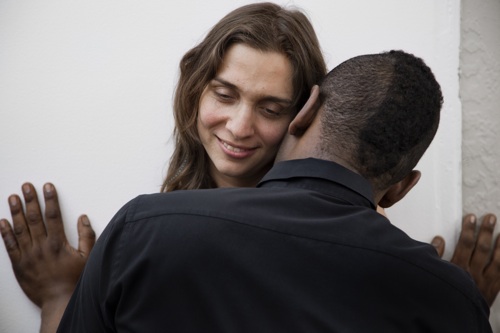
Clifford Owens. Anthology (Kara Walker). C-print. 16x24 inches. Image courtesy On Stellar Rays.
This wasn’t just a performance of coercion and arousal–it was real. Which leads me to wonder, was Owens performing himself as a sexual aggressor, or was he simply being one? I asked Owens why he decided to act particularly macho when performing the score, and he replied that no one would take him seriously if he didn’t approach them with complete confidence. The razor’s edge between performing masculinity and embodying a stereotype was a dangerous one to walk. I left the performance taken with Owens’s ability to possess such a crowd and to keep us captivated in spite of our mixed emotions. Later on, however, I could not shake my sense of personal discomfort. I began to recollect the incidences in my own life where men have crossed the line, times when I have been able to say “no” or fight back, and times when I haven’t.
Looking back on Owens’s performance, I couldn’t be sure what had really happened–if it was ultimately a situation that merely served the artist’s private agenda of sexual validation, or if it in fact brought real-life issues to the fore so that we could openly contend with them. But if it’s the latter–why didn’t I emerge from the performance feeling any different about gender and sexual dynamics than I had before? Perhaps Owens’s performance was not complicated enough. For example, he barely approached men, nor did he interact with people of other gender identifications in the room. Significantly, Walker’s score did not dictate what kinds of people Owens should seduce (other than that they must be adults), or how to seduce them. I thought about confidence and how, in order to make the score bear more urgently on contemporary issues of gender and power, it might have been more challenging if Owens had deliberately sought out encounters with people of a variety of gender identifications. I imagine the resulting acts would have destabilized identity and desire in a way that would have truly elevated the participatory experience to one of shared risk. But on the other hand, maybe I needed to be reminded of my particular subjectivity in this world in precisely the ways that Owens’s performance made me feel. However, my question remains–where do we go from here?
*Editor’s Note: An expanded version of this post will appear as an essay in an upcoming issue of Ideas on Art21.org — look for it in January 2012.

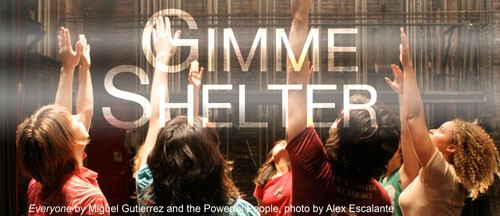



Pingback: Gimme Shelter | Smash Your Idols: Clifford Owens at MoMA PS1 | Art21 Blog | ali tamsin
Pingback: Infiltrating the MoMA Atrium Part 2: Ralph Lemon in conversation with Marissa Perel on “Some sweet day” « Critical Correspondence
Pingback: Here Be Dragons | lauraisaac
Pingback: Here Be Dragons | 10,000 Hours